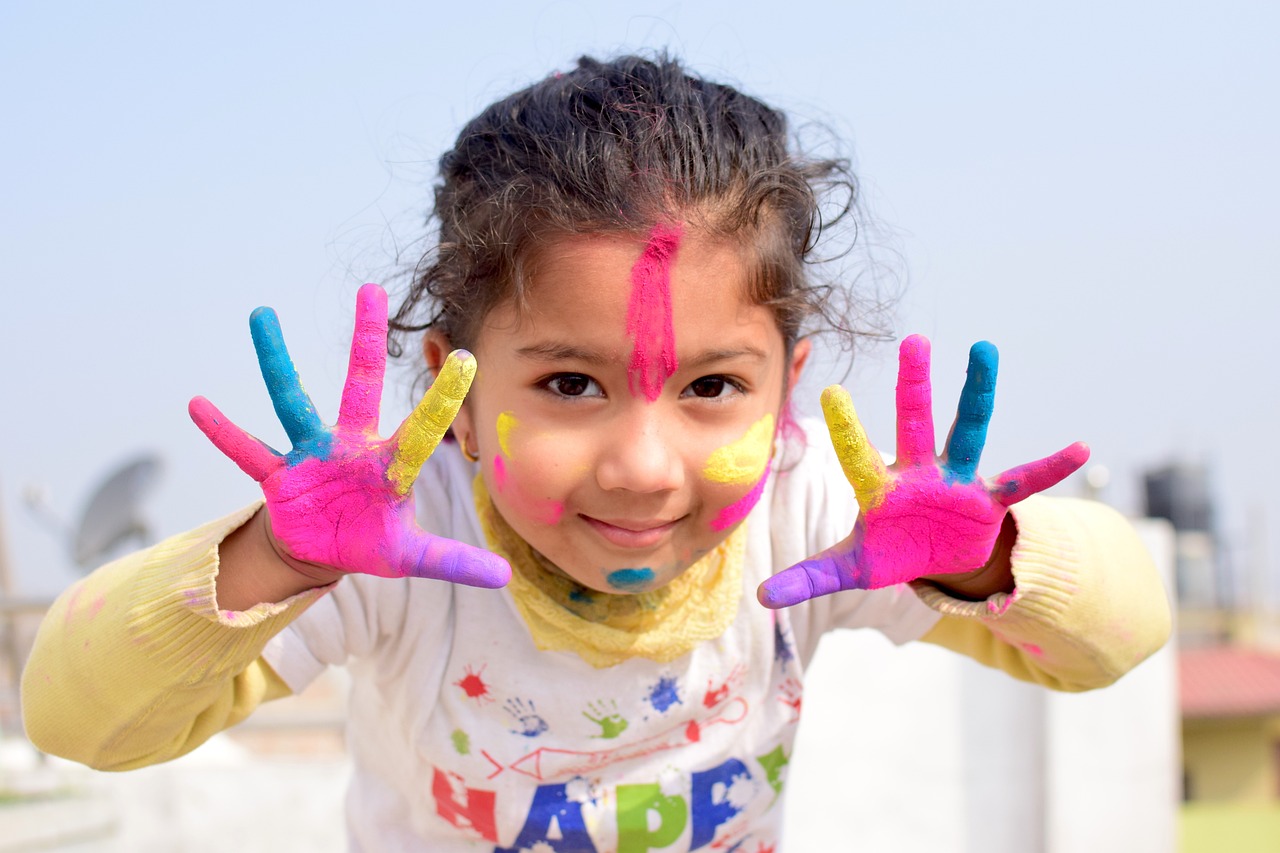There’s a profound saying in India that goes, “Life should be as vibrant as the Colors of Holi Festival,” a sentence filled with depth and shades of meaning, much like the festival itself. As the morning sun peeks over the horizon, India awakens not just to another day, but to a world painted anew in the Colors of Holi Festival.
Holi, a joyous celebration of spring’s arrival, is a phenomenon unlike any other, enveloping the streets of India in a rainbow of hues, each color telling its own unique story. This beloved festival, steeped in ancient mythology and cultural significance, brings together communities, turning cities into canvases of vivid color and jubilant spirit.
As you immerse yourself in our exploration of the Colors of Holi Festival, picture the powdered colors, known as ‘gulal,’ floating in the air, transforming the landscape into a riot of color. Picture the faces around you, each one painted in a mosaic of colors, beaming with joy, their laughter echoing through the air. Picture the spirit of unity and festivity that transcends age, gender, and social status. But most importantly, picture the emotions that these colors evoke, the stories they narrate, and the traditions they uphold.
1. Red: The Color of Love and Passion
One cannot discuss the Colors of the Holi Festival without mentioning the fiery and vibrant red, a color deeply symbolic in Indian culture. Used in many religious ceremonies, red signifies love, passion, beauty, and fertility, making it a predominant color during Holi.
In the context of Holi, the use of the red gulal is linked with Hindu mythology, specifically with the eternal love between Lord Krishna and Radha. According to legend, Krishna was worried about the difference in skin color between him and his beloved Radha. His mother playfully suggested that he could change Radha’s skin color by smearing her with colors. Taking this to heart, Krishna smeared Radha’s face with red color, symbolizing love and attraction. This playful act was well received and thus, began the tradition of ‘rangwali Holi.’
During Holi, as you walk down the streets of India, you will notice an abundance of red. It streaks across faces, marking not just the skin but the jubilant hearts beneath. As the red gulal leaves your hand, sailing through the air to dust another’s face, it carries your wishes for love, passion, and vitality to the recipient.
Furthermore, red is the color of the ‘Holika Dahan, or the bonfire that is lit on the eve of Holi, signifying the victory of good over evil. This is another layer to the color’s significance, as it is a symbol of power and the destruction of negativity. The red flames, licking the dark sky, are a sight to behold and a clear message that light will always overcome darkness.
As you can see, the color red carries so much meaning, all interconnected and profound. It represents the depth of emotions, the strength of passion, and the power of positivity, making it a significant part of the Holi festival’s color palette.
2. Green: The Color of Life and Rebirth
As the green gulal takes to the skies during Holi, it signifies the reawakening of the earth after a long, harsh winter. Green is the color of life, fertility, and renewal. It epitomizes the arrival of spring, a season when nature rejuvenates itself, mirroring the ethos of Holi itself — the renewal and strengthening of relationships.
Historically, green has a special place in Indian culture. It is associated with the goddess of wealth and prosperity, Lakshmi. It is often worn by brides to symbolize fertility and productivity. It also represents the agricultural prosperity of the nation, which forms the backbone of its economy.
During Holi, green paints a vivid picture of humanity’s connection with nature. The air is thick with the fresh scent of spring, the environment buzzing with energy and enthusiasm. As the green color touches one’s skin, it carries a silent prayer for good health, prosperity, and a bountiful harvest.
But beyond its evident representation of nature and fertility, green also promotes a feeling of relaxation and tranquility, providing a calming balance amidst the high energy of Holi celebrations. Amid the spirited laughter and festive chaos, the sight of green offers a moment of peace, a chance to take a deep breath and simply enjoy the merriment around.
3. Yellow: The Color of Knowledge and Learning
The color yellow, with its bright and cheerful allure, holds a prominent place in the Holi festival. It stands for knowledge and learning, symbolizing the mind’s illumination when ignorance is dispelled.
In Hindu tradition, the color yellow is associated with the planet Jupiter, considered the teacher of the gods, further establishing its link with knowledge. It’s also the color of turmeric, a spice extensively used in Indian rituals for its medicinal and purifying properties.
During Holi, the splashes of yellow serve as a reminder of the importance of learning in life. It symbolizes the human yearning for a deeper understanding of life and the world. Each speck of yellow gulal in the air carries the profound message that life is a continuous learning journey.
Moreover, yellow represents optimism, bringing warmth and brightness into the celebrations. It’s like the morning sun that brings hope after a night of darkness, or the blooming mustard fields that are a common sight in rural India during this period, signaling a prosperous season ahead.
So, when you see the color yellow during Holi, think of it as a beacon of hope, warmth, and enlightenment, driving away ignorance and pessimism and bringing in a wave of positivity.
4. Blue: The Color of Divinity and Tranquility
The color blue finds its place in the Holi festival as the representative of the divine and the serene. In the Hindu pantheon, Lord Krishna is depicted with a blue complexion, further cementing its spiritual significance. The color reflects the infinite nature of the sky and the ocean, both elements that transcend the tangible and symbolize vastness, mystery, and depth.
When the sky of Holi is dotted with clouds of blue gulal, it creates a surreal spectacle. The use of blue is not just a nod to the divine connection but also a homage to the tranquil nature of the color. Amidst the fervor and frolic, blue serves as a calming influence, a moment of serenity that underlines the festival’s spirit.
Beyond its spiritual significance, blue also stands for trust, loyalty, and wisdom. It is a reminder of the human capacity for inner peace and steady wisdom, even amidst chaos. It underlines the unity that the festival stands for, urging one and all to trust in the power of togetherness and shared joy.
5. Pink: The Color of Care and Compassion
Next in the rainbow spectrum of the Holi festival comes the color pink, a hue that resonates with feelings of care, compassion, and love. The color pink in Indian culture is often linked with the feminine and is a popular choice for the garments of women.
In the riot of colors that is Holi, the presence of pink adds a gentle touch, like a soft whisper amid the loud cheers. It paints pictures of love and care and brings an element of sweetness to the festivities. Every fleck of pink color that dyes the skin subtly passes on the message of kindness and unconditional love.
Additionally, pink is associated with the bloom of the cherry blossom, a flower known for its delicate beauty and transient existence. This symbolism subtly reminds us to appreciate the fleeting, yet beautiful moments of life and to live every moment to the fullest, very much echoing the spirit of Holi.
In the pink splashes of Holi, we find a gentle reminder to show compassion and to nurture the bonds of love, emphasizing the festival’s central theme of unity and togetherness.
6. Orange: The Color of Creativity and Spirituality
As we move further along the color spectrum, we come across the warm hue of orange. A vibrant blend of red’s passion and yellow’s joy, orange represents creativity, enthusiasm, and spirituality in the Colors of Holi Festival. It’s a hue often linked with the sacred fire that burns away impurities, symbolizing purity and transformation.
In the Holi festival, orange brings the warmth of the sun, spreading light and cheer amid the celebrations. It resonates with the vibrancy of marigolds, a flower that is deeply entrenched in Indian religious and cultural ceremonies.
The sight of oranges during Holi stimulates creativity, stirs up feelings of adventure, and encourages social interaction. It’s a color that provokes change, inspiring people to step out of their comfort zones and embrace the spirit of Holi, much like the transformation that the festival itself ushers in.
Moreover, as a symbol of spirituality, orange emphasizes the importance of Holi as not just a physical celebration, but also a spiritual journey. Each speck of orange in the air carries a silent prayer for transformation and spiritual growth, adding a deeper layer of meaning to the festivities.
7. Purple: The Color of Luxury and Ambition
Following orange, we have the majestic purple, a color that has, for centuries, been associated with luxury, ambition, and power. It’s a color that stands out in the vibrant palette of Holi, adding an element of richness and regality to the celebrations.
Purple is a unique blend of the calm stability of blue and the fierce energy of red, reflecting a balance that is central to the ethos of Holi. The color purple often appears in Indian art, culture, and attire as a representation of wealth and power. But during Holi, it serves as a reminder of our aspirations and our potential for greatness.
Amid the joyous chaos of the festival, the sight of purple brings a sense of ambition and potential, urging individuals to aim high in their endeavors. It subtly inspires one to harness their inner strength, aspire for more, and embrace the power within.
In the context of Holi, the presence of purple carries a profound message: while the festival is a celebration of the present, it also encourages one to aim for a better and brighter future. It’s a beautiful reminder of life’s limitless possibilities and our capacity to achieve them.
8. Brown: The Color of Earth and Stability
Among the vibrant and bright colors of the Holi festival, we find the humble brown, often overlooked, yet deeply significant. Brown, the color of the earth, symbolizes stability, reliability, and resilience in the context of the Holi festival.
In Indian culture, brown has a symbolic association with service, duty, and commitment, as it resonates with the steadfastness of the earth. It represents the groundedness and the simplicity of life, subtly reminding us of our roots and our connection to the natural world.
During the Holi festivities, amidst the joy and exhilaration, the sight of brown is a quiet yet powerful reminder of our inherent strength and resilience. It symbolizes the spirit of endurance that forms the bedrock of human life, similar to the earth’s unwavering support.
While brown might not be as flashy as red or as serene as blue, it is this color that carries the weight of significance. It is a testament to the festival’s inherent message of resilience, of standing firm in the face of adversities, much like the human spirit that continues to persevere.
9. White: The Color of Purity and Peace
Finally, in our exploration of the Colors of the Holi Festival, we come to white, a color synonymous with peace, purity, and innocence. It’s the canvas upon which the other colors of Holi come to life, a symbol of wholeness and completion.
In Indian culture, white holds a special place. It’s the color of light, a beacon of truth, and the embodiment of the divine. It’s often worn during religious ceremonies and is a color that transcends the physical, representing the unchanging, eternal aspect of the universe.
During Holi, the presence of white is particularly profound. As people don white clothes, they become live canvases, ready to be painted with the colors of joy and unity. It symbolizes openness and acceptance, a willingness to embrace the spirit of Holi and to engage in the shared joy it brings.
The sight of white also brings a sense of peace amid the high-energy celebrations, providing a balance. It reminds us of the purity of heart and the innocence of spirit that the festival seeks to awaken in us.
Through exploring the colors of the Holi festival, we understand the depth and richness of this beautiful celebration, a tradition that paints not just bodies and streets, but also the human heart, with its vibrant palette.
10. The Symphony of Colors: The Grand Finale
As we culminate our exploration of the Colors of Holi Festival, it’s essential to appreciate the grand symphony that these colors create together. They don’t exist in isolation; instead, they interact, blend, and contrast to form a vibrant mosaic that is much more than the sum of its parts.
The festival of Holi is a testament to the beauty of diversity and unity. The variety of colors used during this event symbolizes the diversity of India, a country known for its rich cultural, linguistic, and regional variations. Yet, when these colors come together during Holi, they paint a picture of unity in diversity, a fundamental principle of the Indian ethos.
When the colors of Holi are smeared on each other’s faces, all distinctions blur, and everyone comes together in the spirit of celebration. This is the magic of Holi; it’s a festival that transcends social barriers and promotes love, togetherness, and a sense of shared joy.
Beyond the joy and the playfulness, Holi colors carry a profound message. They remind us of life’s vibrancy and dynamism, of the joy that comes from embracing diversity and celebrating unity.
So, the next time you find yourself amidst the Holi celebrations, remember that each color you see, each hue that adorns your skin, carries a message, and tells a tale.
As we complete our journey through the vibrant Colors of the Holi Festival, remember the underlying essence of this grand celebration – unity, love, joy, and the vibrant tapestry of life.
We welcome any suggestions or questions. You can email us or contact us using the contact page.
You can also connect with us on the following social networks:









0 Comments